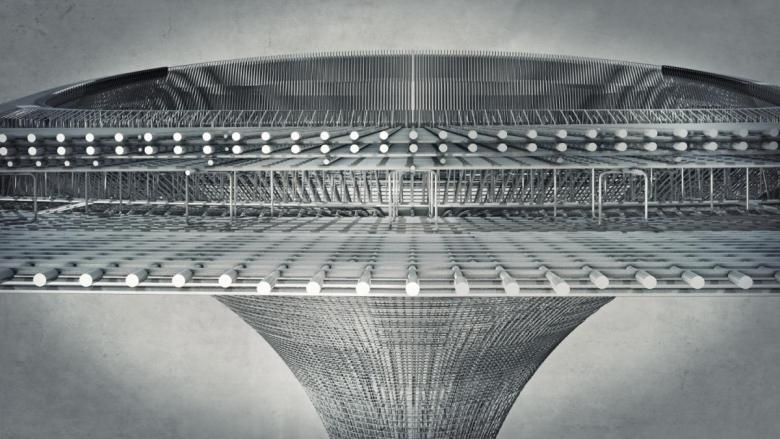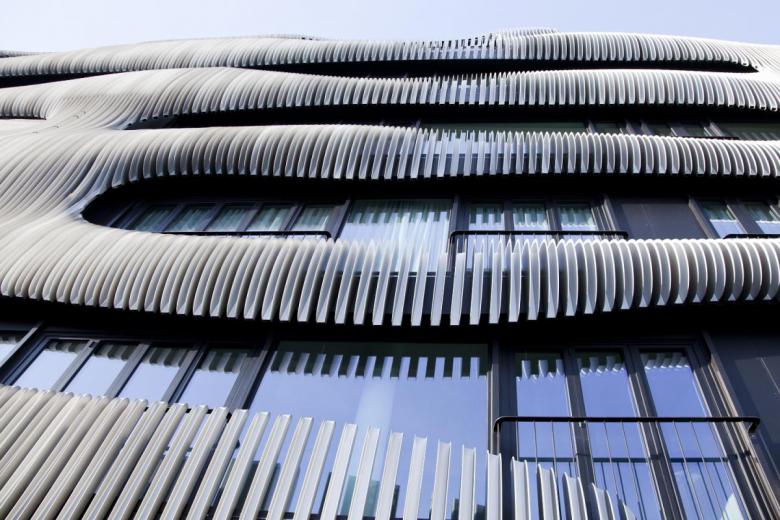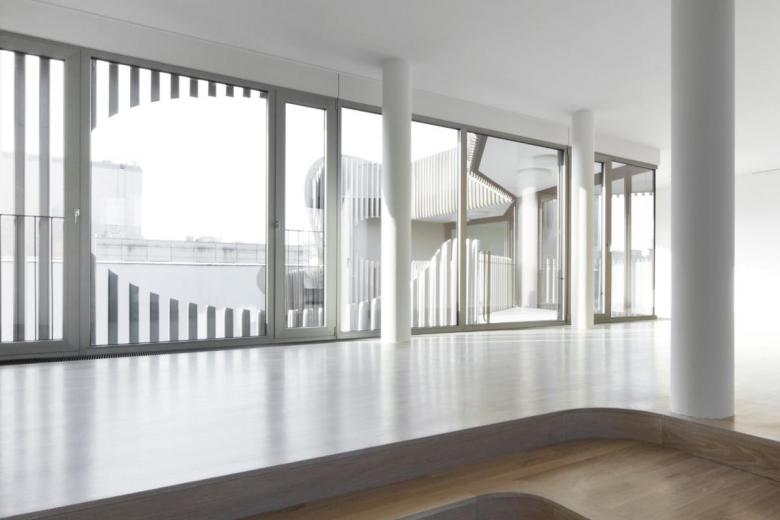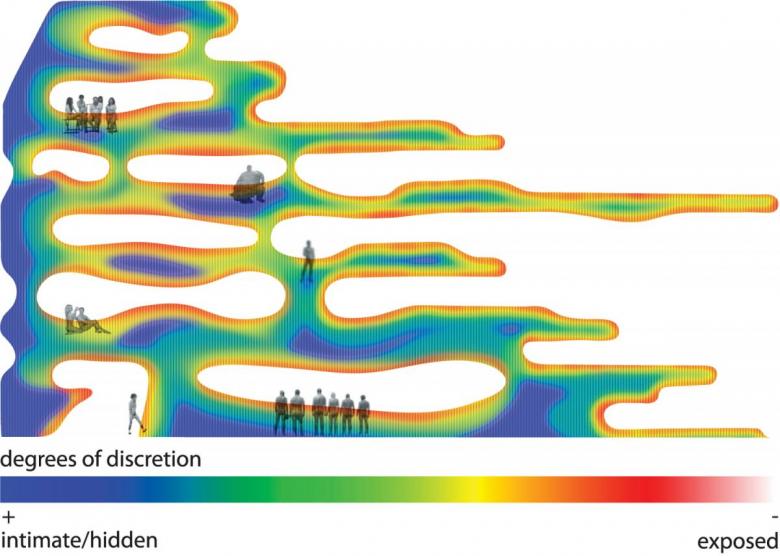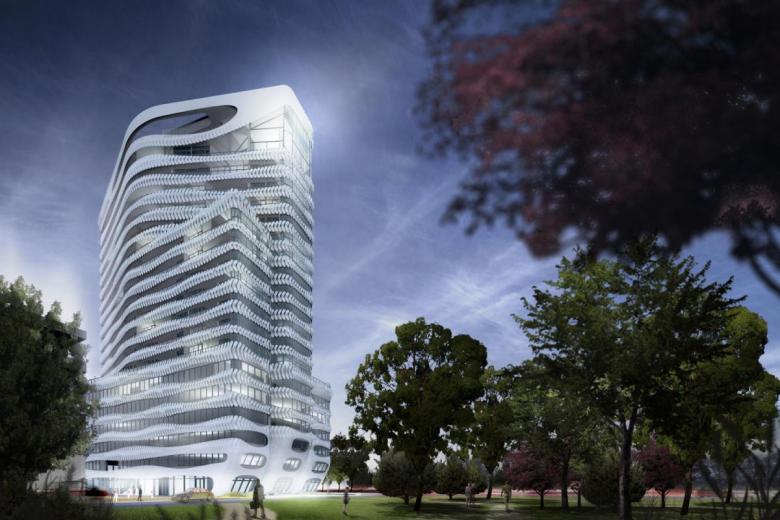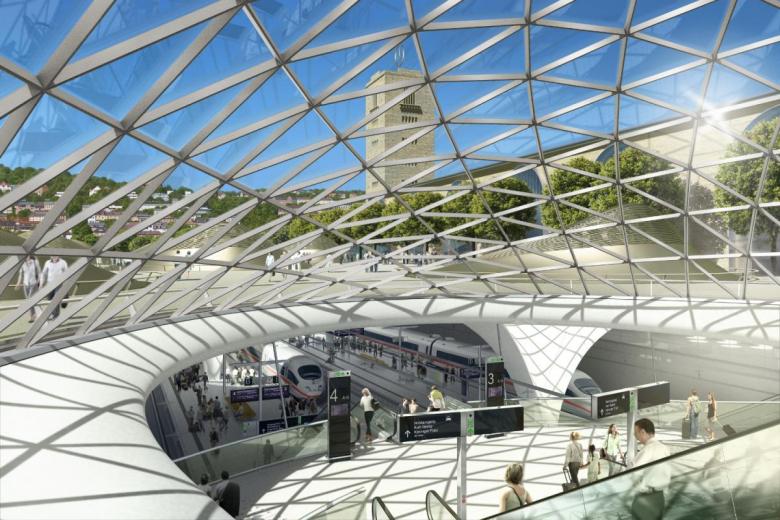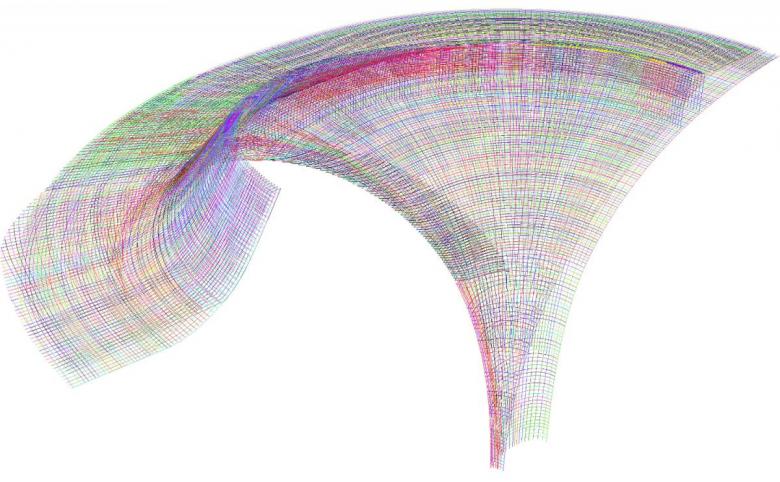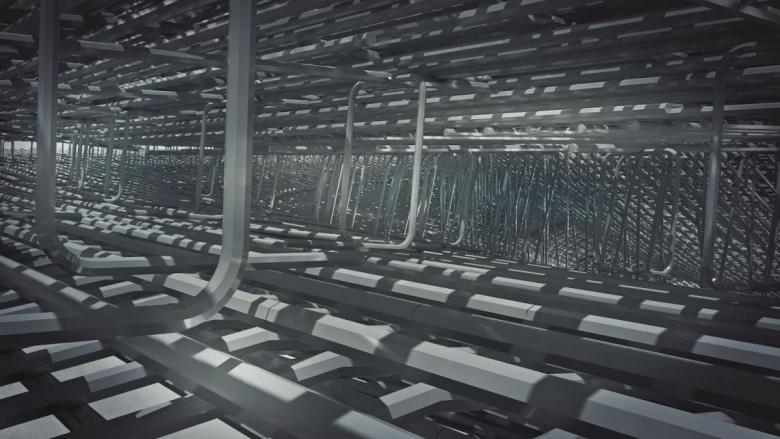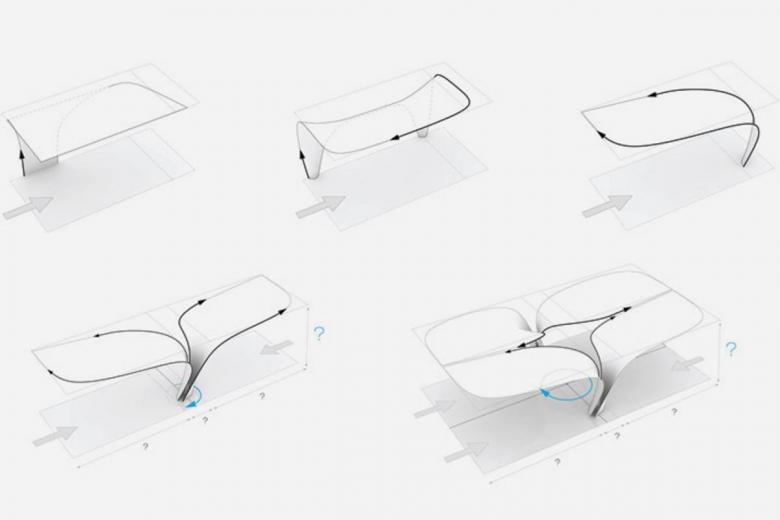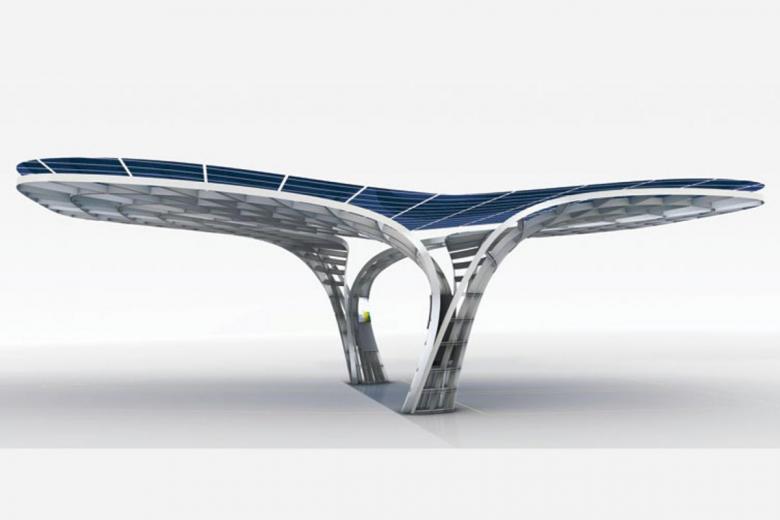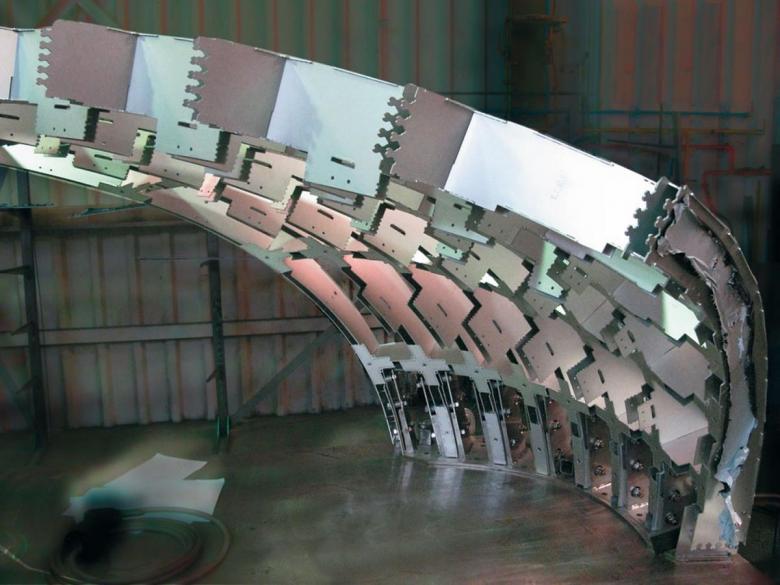Architecture 4.0
Carsten Sauerbrei
12. 七月 2017
BIM model of reinforcement rods inside a chalice-shaped column of the new Stuttgart underground station (Image: Werner Sobek)
Parametric design, building information modeling, computer-aided manufacturing – these terms represent the digital change in architecture and the building industry. Such architects as Jürgen Mayer H. and Tobias Wallisser, as well as engineers like Werner Sobek, are carrying out pioneering work in this area.
"Digital is Better": A 1995 song by the German rock band Tocotronic already praised the digital future. In the previous decade, CAD programs had started to replace drawing boards in the offices of architects and engineers. Today, more than 20 years later, the next paradigm change is taking place in Germany: the switch from a digitally supported 2-D planning process to a completely digital, 3-D-based process chain, moving from design to planning through to implementation. This change can be noticed in Germany in, among other things, the Bauen 4.0 master plan presented by Minister of Transport Alexander Dobrindt in early 2017, as well as in the BIM manual, BIM für Architekten: 100 Fragen – 100 Antworten ("BIM for Architects: 100 Questions – 100 Answers"), co-published by the Federal Chamber of Architects in 2016. In this article we present three German offices that play a leading role in shaping the digital change in architecture and building and serve to identify its opportunities and risks.
Analogue and Digital Sculptural Quality
The façade of the apartment building on Johannisstraße, Berlin, was developed from a parametric model. (Photo: P. Parinejad)
Berlin's J. MAYER H. and Partners is one of the German architecture firms that is intensively involved in progressing digitalization. When asking Jürgen Mayer H. about the use of digital tools in the design process, his answer is not as clear as one might expect: "With every project we decide anew where analogue or digital tools are better suited for the design process." So architecture cannot only be understood on the computer; sometimes it is easier to comprehend when working with a traditional model.
Having said this, Jürgen Mayer H. also uses digital and parametric building models in the planning phase. As he describes it, their advantages include a better understanding of complex framework conditions and the possibility to make visualizations, animations and changes faster and easier. Building Information Modeling (BIM), on the contrary, has only recently started to play an increasingly important role in their office.
The parametrically planned lamella façade had to provide protection against views from the outside and simultaneously afford optimal views from inside the building. (Photo: Ludger Paffrath)
JOH 3, the apartment building completed on Berlin' Johannisstraße in 2012, is one of the projects J. MAYER H. and Partner developed by means of a parametric building model. The glass façade of the building had to protect against views from the outside with a lamella structure, which was coordinated with the very different apartment layouts and the neighboring buildings. At the same time, the residents had to be able to enjoy optimal views. The parametric façade model represented the result of these criteria by zoning the living space according to different levels of discretion – from intimate to exposed – and thus provided the basis for the development of the building's external form.
The diagram shows the street façade's varying levels of discretion, which determined the length and curvature of the lamellas. (Image: J. MAYER H. and Partner)
Jürgen Mayer H explained that the form-finding process determining the exact position and shape of the aluminum lamellas was reached by alternating between analogue and digital media. Subsequently, the architectural data had to be translated into production data, which was then forwarded directly to the metal construction company. With his current project, the RKM 740 tower block in Düsseldorf, Jürgen Mayer H. complements this procedure with a feedback process between architects and engineers to further optimize the façade in terms of economy.
The façade of the RKM 740 tower block was developed by means of a parametric model. (Image: J. MAYER H. and Partner)
BIM at Its Best
Parametric design and BIM do not only play a crucial role in everyday planning routines of architects; they have been equally important for German engineers for just as long. This is confirmed by Roland Bechmann, managing director and partner of Werner Sobek – Engineering & Design from Stuttgart. In a conversation about this topic he states: "A pioneer in 3-D planning was the Mercedes Benz Museum in 2006. Over the last eight to ten years, we have regularly used digital 3-D planning. For the last five years, we have used BIM in every project."
Visualisation of the ThyssenKrupp Test Tower in Rottweil, which used BIM in the competition stage. (Image: Werner Sobek)
For Roland Bechmann, the advantages of a consistent application of digital 3-D planning are perfectly clear. Previously their plans had to always follow after the drawings of the architects in the case of changes. Today, changes and amendments are automatically transferred. He explains: "Due to the increasing complexity of projects, it has become necessary to work on a shared, digital building model with an interdisciplinary team."
The roof of the new Stuttgart underground station rests on chalice-shaped columns, whose complex geometry would have been impossible to implement without BIM. (Image: ingenhoven architects)
The fact that the planners at Werner Sobek Group incorporate BIM in their planning process to an extent hardly achieved by any other German office is illustrated by two prizes the office won in the context of the BIM Award 2016, one for the ThyssenKrupp Test Tower in Rottweil, developed in collaboration with JAHN Architects from Chicago. "Even in the competition we already exchanged data with the construction firm," Bechmann stated, about the very early start of interdisciplinary collaboration. Therefore they were able to present the client a reliable cost estimate and coordinate the complex scheduling with the construction firm by means of BIM-based assembly progress plans.
For the Stuttgart 21 project, ingenhoven architects and Werner Sobek worked together with a shared BIM model. (Image: Werner Sobek)
Compared to the ThyssenKrupp Test Tower, the BIM application for the Stuttgart 21 project goes one step further. Here, the structural engineers at Werner Sobek, together with ingenhoven architects, worked jointly on a three-dimensional overall model. "Usually, BIM stops at the formwork planning level of detail. In this project, however, we used BIM to determine the positioning of the reinforcement rods for the first time," Roland Bechmann described. He added: "Just like on other levels of detail, there has been a multi-stage optimization process with the construction company on the basis of parametric clash control. This was absolutely necessary given this complex geometry, which cannot be represented in 2-D plans."
The structural engineers and construction companies used BIM even for the position of reinforcement rods. (Image: Werner Sobek)
Digital Networking
The Laboratory for Visionary Architecture (LAVA), with branches in Berlin, Stuttgart and Sydney, applies digital design and planning tools to enhance efficiency, but also much else. Starting from their specific possibilities, the architects of this network are interested in a new understanding of architecture. So it does not come as a surprise when Tobias Wallisser, together with Alexander Rieck and Chris Bosse, partners of LAVA, responds to the question of the significance of digital tools as follows: "We only design digitally. Firstly, we create a digital model, and only later it is used to generate plans."
LAVA based the shape of the Solar Charging Station on the model of a leaf. (Image: LAVA)
"We are particularly interested in networking along the digital process chain," emphasizes Tobias Wallisser. In other words, a preferably uninterrupted digital work process, from design through to execution. According to Wallisser, the great advantage of such a digital, networked planning process is the possibility to receive feedback from engineers or construction companies on economic efficiency, implementability, or material efficiency in the design phase, and then be able to react to it.
The complex, double-cambered support structure lends the solar charging station a distinctive appearance. (Image: LAVA)
Wallisser summarizes his experience: "Digital planning can represent a greater complexity, process more design-relevant data, and thus achieve better solutions." The example of a new market hall at Frankfurt Airport's T3 terminal clearly illustrates what he means: "In this project, we combined parameters such as visual axes, incident light, and layout of circulation routes and reached the conclusion that flowing shapes would better direct the movement of potential buyers than conventional 90-degree angles and would use the floor plan more intensively."
LAVA developed an efficient and easy-to-assemble and -disassemble push-fit system for the complex support structure of the solar charging station. (Image: LAVA)
In fact, LAVA relies on digital technology through to the implementation of projects and is thus, apart from the ITKE/ICD Research Pavilion in Stuttgart or individual projects by other offices, still an exception in Germany. The Solar Charging Station, completed in 2014 in Munich, is a good example of CAM, computer-aided manufacturing. For the complex, double-cambered structure, LAVA, together with Arnold Walz from Design-to-Production, developed an economic, easy-to-assemble and -disassemble push-fit system. A laser cutter automatically separates the single-system components from flat aluminum sheets on the basis of machine data, which are read directly from the 3-D data sets of the parametric architectural model.
A laser cutter automatically separated the single parts of the push-fit system from flat aluminum sheets. (Photo: LAVA)
Opportunities and Risks
The continually progressing development of digital work methods has a great potential to shape design, planning, and building processes to achieve greater efficiency, safety, and sustainability. New possibilities also arise in terms of aesthetics if digital tools can facilitate the cost-efficiently implementation of complex geometries. Apart from many questions which have not been sufficiently answered – such as an alteration to planning sequences, architectural fees or data protection – Jürgen Mayer H. and Roland Bechmann consistently emphasize the main risk of digitalization: the general misconception that good design work can be completely replaced by digital processes.
This article originally appeared as "Architektur 4.0" on German-Architects. Translation by Bianca Murphy.
